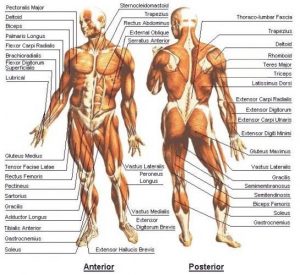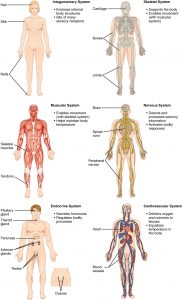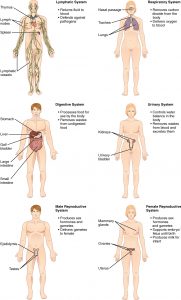3.1.4 Healthy Body Processes
Normally functioning bodies complete numerous processes and functions–many of which are performed by dedicated body organs. We can group the body’s organs and parts into 11 body systems, as follows:
- respiratory system
- integumentary system
- skeletal system
- nervous (sensory) system
- muscular system lymphatic system
- circulatory (cardiovascular) system
- digestive system
- urinary (renal) system
- endocrine system
- reproductive systems
Please refer to the following visuals for detailed representations of each body system. Click each side of the image to view an enlarged version. The linked versions can also be magnified by clicking on the image:
In this next section, you will review the processes and functions of a healthy body, system by system. You will not learn about all 11 systems here, but only those that are most applicable to observing and assessing your client’s health. Using the links provided, view the video(s) for each system to refresh your understanding of how these body processes should function in a healthy body. Then, for each system, you will complete a short exercise to check your understanding of what you have learned.
If you already have strong knowledge about a specific system, you may choose to skip to the next one. If you choose to complete all videos on this page, it will take you some time to complete. All videos have time stamps provided for your reference.
Your goal at the end of this page is to have a strong understanding of how the different systems in the body should function when everything is working properly, and to begin to grasp how issues in the body may affect some systems and not others.
The Respiratory System
Watch the following two videos about the respiratory system and how it works in a healthy body:
- Respiratory System, Part 1: Crash Course A&P #31 (9:21)
- Respiratory System, Part 2: Crash Course A&P #32 (10:22)
Practice Makes Perfect
Drag and drop the labels to the correct places on the respiratory system diagram.
The Integumentary System
Watch the following two videos about the integumentary system and how it works in a healthy body:
- The Integumentary System, Part 1 – Skin Deep: Crash Course A&P #6 (9:39)
- The Integumentary System, Part 2 – Skin Deeper: Crash Course A&P #7 (9:56)
Practice Makes Perfect
The Skeletal System
Watch the following video about the skeletal system and how it looks in a healthy body:
Practice Makes Perfect
The Muscular System
Watch the following video about the muscular system and how it works in a healthy body:
Practice Makes Perfect
Challenge yourself. Review the following three body actions, and the muscles that are involved in producing this response. If you like, you can use the diagrams provided below as a reference point. Are the muscles located where you expected them to be? Do you understand the connection between the contractions of these muscles and the movements we are looking at?
- Which muscles are used to drink a cup of coffee?
- Pectoralis Major
- Deltoid
- Coracobrachialis
- Biceps Brachii
- Which muscles are used to kick a soccer ball?
- gastrocnemius
- hamstrings
- iliopsoas
- quadriceps
- gluteal muscles
- What muscles are used for the butterfly stroke in swimming?
- pectoralis major
- latissimus dorsi
- biceps brachii
- brachialis
- triceps brachii

The Nervous (Sensory) System
Watch the following videos about the nervous system and how it works in a healthy body, as well as a few of the key senses that you will assess in your practice:
- The Nervous System, Part 1: Crash Course A&P #81 (10:35)
- Vision: Crash Course A&P #18 (9:34)
- Hearing & Balance: Crash Course A&P #17 (10:39)
- Taste & Smell: Crash Course A&P #16 (10:29)
Practice Makes Perfect
The Digestive System
Watch the following video about the digestive system and how it works in a healthy body:
Practice Makes Perfect
The Urinary System
Watch the following video about the urinary system, also called the renal system, and how it works in a healthy body:
Practice Makes Perfect
Challenge yourself! Now that you know about the basic process wherein the body makes urine, how much do you know about the health implications of this process?
The Circulatory System
Watch the following video about the circulatory system, also called the cardiovascular system, and how it works in a healthy body:
Practice Makes Perfect
Try out this short quiz to see how much you know about the circulatory system.
Media Attributions
- Body Systems 1 © Connexions is licensed under a CC BY (Attribution) license
- Body Systems 2 © Connexions is licensed under a CC BY (Attribution) license
- Human_Body-Muscular © Unknown is licensed under a CC BY-SA (Attribution ShareAlike) license



